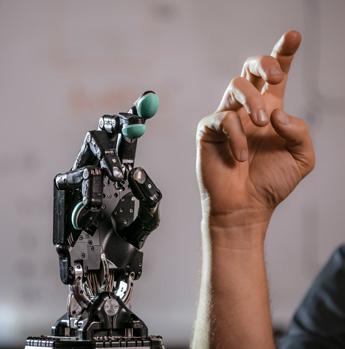
2 minute read
‘BEACON OF HOPE’
New Home for Neuroscience Research
The three-story, state-of-the-art facility was designed as a collaborative hub for neuroscience to foster connections and serve as a global destination for the world’s brightest scientists and students. The institute serves as a “beacon of hope” for research into numerous brain and behavioral disorders.
The FAU Stiles-Nicholson Brain Institute was made possible by a $10 million gift from David J. S. Nicholson, who championed the idea of a new brain research, education and community engagement institute. The $35 million research space represents a significant investment by the state of Florida, FAU and its research partners.
“As we officially open the doors to the FAU Stiles-Nicholson Brain Institute, we are poised to accelerate the discovery and translation of novel therapies and treatments that will provide new hope for patients within our communities and worldwide. Importantly, the FAU Stiles-Nicholson Brain Institute will invigorate interest among young people to pursue STEM as a career and ultimately improve our nation’s rankings in science and math education,” Nicholson said.
The first floor houses the Center for Brain Disease Modeling, a facility designed to develop and advance approaches to study brain disorders, including Alzheimer’s disease, autism, addiction and brain cancer. A key feature of the second floor is the Advanced Cell Imaging Core Laboratory, where the visualization of brain cells takes place. Multidimensional, dynamic cellular and brain circuit visualization merges with computational and virtual reality resources in this space to allow researchers to peer deeply into the brain.
The second floor of the building also contains more than $1 million in already acquired equipment and houses one of 14 Nikon Centers of Excellence in the United States. Plans for the third floor will be announced in the coming months.

“We believe that the impact from bringing together the brightest minds within this facility to unravel the secrets of the brain will improve the quality of people’s lives for decades to come,” said Randy Blakely, Ph.D., executive director of the Brain Institute, David J. S. Nicholson Distinguished Professor in Neuroscience, and professor of biomedical science in FAU’s Charles E. Schmidt College of Medicine.

Advancing Prosthetics
More than 1.6 million Americans have suffered the loss of a limb. Despite advancements in technology, prosthetics still are not completely sufficient. Researchers at FAU want to change that.
Current prosthetic hands have five individual digits, yet only one grasp function can be controlled at a time. That means simple tasks like using a screwdriver or a can opener — let alone more complex tasks — are largely impossible, according to Erik Engeberg, Ph.D., professor in FAU’s College of Engineering and Computer Science and member of the FAU Stiles-Nicholson Brain Institute.

“Anything exceeding basic functionality remains elusive for prosthetic hands even though they are mechanically capable of such feats,” said Engeberg, who recently was awarded a four-year, $1.2 million grant from the National Science Foundation to work with amputees to learn advanced control over more sophisticated prosthetic hands, with an automated training regimen that can be used at home.
The project involves a novel bimodal skin sensor that combines machine learning motor intention classification algorithms and reinforcement learning. Clinicians will interact with 10 study participants over the course of one year for muscle training using a smartphone.
“Automating this aspect of health care with remote learning functionality can help disabled people access treatment more quickly, more conveniently, and at a lower cost,” Engeberg said.










